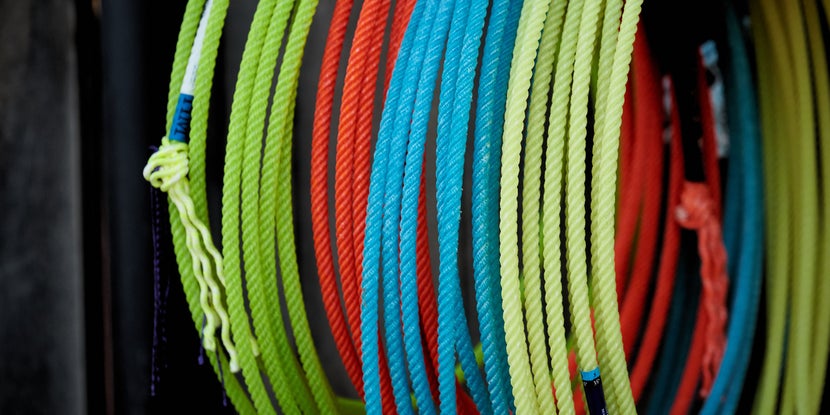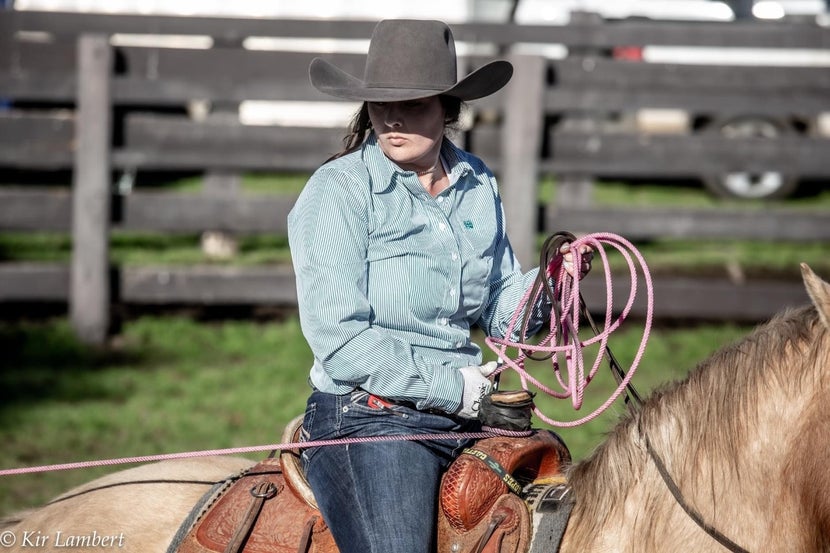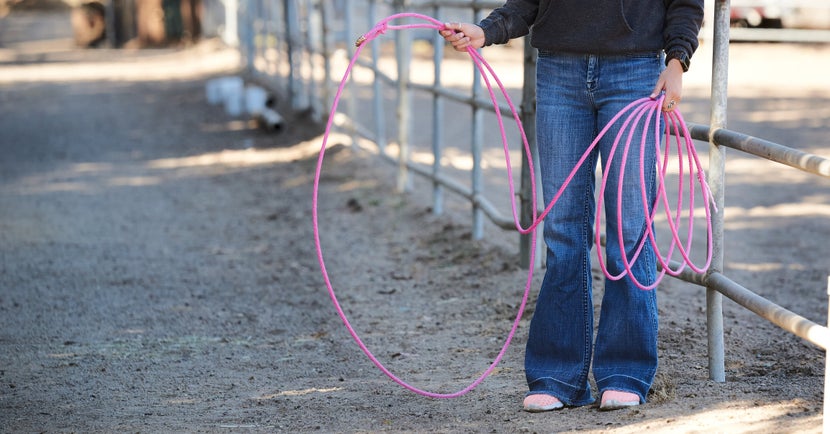Breakaway Ropes & Team Ropes:
A Buying Guide
Your personal preference is a huge consideration when choosing the right rope, but you will also be influenced by the roping event you are participating in. We know how important is is for your rope to feel good in your hands, so you can perform your best! We've gathered information from our own roping experience, sponsored rider tips, and customer feedback to put together the ultimate rope buying guide for you. Whether team roping or breakaway roping is your game, there are many factors to keep in mind as you are considering a rope. This guide will help you understand the features and functionality of head, heel, and breakaway ropes. We will also answer some commonly asked questions to better address your roping curiosities!
Types of Ropes
Let's first address the differences between the types of ropes. Since ranch ropes are not generally used in competitions, we won't be focusing on them in this guide. However, this breakdown will help give you a broader understanding of ropes in general! We will cover more roping terminology later.

Head Ropes
Head ropes are used to catch a steer's horns. It is the header's job to turn the steer left to enable their heeler partner to rope the steer's two hind legs. Head ropes are generally softer in feel and shorter in length.
Heel Ropes
Heel ropes are used to rope both hind feet of a steer. Once the header catches and turns the steer (which causes the steer to hop), the heeler can throw their loop and catch both of the steer's hind feet. Heel ropes are generally stiffer and longer.
Breakaway Ropes
Similar to calf ropes, breakaway ropes are used to rope a calf in a timed event called breakaway. In this event, the calf is roped, you stop your horse, then the rope breaks away from your saddle horn. The rider with the fastest time wins! Breakaway ropes generally have a softer feel and are shorter in length than a head rope; they are also made in varying weights, depending on the roper's style.
| Type of Rope | Lay/Stiffness | Length |
| Head | Super Soft (XXS or SS), Extra Soft (XS), Soft (S), Medium Soft (MS) | 30-31 ft |
| Heel | Soft (S), Medium Soft (MS), Medium (M), Medium Hard (MH) | 35 ft |
| Breakaway | Extra Soft (XS), Soft (S) | 24-29 ft |
Rope Materials
Blended Ropes
Ropes that are manufactured with an elastic material (ie. polyester, nylon, rubber) revert to their original state more easily. Because elastic has more of a "memory," bouncing back to its manufactured shape after it is stretched out, its effects will be more noticeable in warmer weather.
Poly-nylon ropes will have more "body" to them, putting more weight in your hand, which can aid in keeping your loop open when you throw. This feel is ideal for roping large-horned cattle, since you want your loop to stay a bit more open to ensure you can catch both horns.
Fiber-poly blended ropes tend to be a better choice in the warmer summer months, as heat causes your rope to expand and swell up—making it feel tighter in your hands. Again, your choice of material when it comes to blended ropes is dependent upon your personal preference; use what works best for you!
100% Nylon Ropes
Ropes made from 100% tend to keep their "shape" and have a more consistent feel in various weather conditions; most rope brands will offer this material option. A 100% nylon rope also tends to break in quickly—once you rope the dummy a handful of times, it will keep the "stretch" you have put in it. In other words, nylon ropes will hold onto that broken-in feel more reliably than a poly blend rope (which tends to take more time to break-in before it stops reverting back to its manufactured state).
Ropes constructed of 100% nylon do not react as much to weather, which may be a positive or a negative depending on your preferences. With a better understanding of the different rope materials and how they interact, you can more easily navigate the options we have to offer!
First Rope for the Beginner Roper
Those new to the roping practice will not have established personal preferences yet to aid them in finding their ideal rope(s). Beginner ropes are traditionally lightweight, small in diameter, and shorter in length. A smart choice for a first-time roper is the Rattler Triton4 Team Head Rope. We also recommend the Classic Heat Head Team Rope for its softness that stays consistent in feel over time. To get a further jump start on roping, we highly suggest you take a look at our guide on How to Start Roping—which is specifically tailored to beginners!
Do you have a kiddo wanting to mess around with a rope? The Fast Back Kid's Vapor Rope is perfect for the young cowboy or cowgirl wishing to throw! Otherwise, get yourself situated with all of the accessories needed for your own roping start.
| Shop All Rope Accessories |
Rope Factors to Consider
Rope Diameter
The diameter of the rope is important to keep in mind when making a selection; choose a rope that best suits your hand while you're holding the reins. If it is difficult for you to hold both the reins and rope in one hand, you are likely to become frustrated when roping.
Team ropes typically have a three-eighths inch diameter. When the diameter of the rope is three-eighths inches, it is known as a "true" or "full" rope. When the diameter is smaller, it is described as a "scant" or "light" rope. We recommend a true three-eighths inch rope for beginners starting to rope.
For breakaway ropes, the sizing is slightly different. In roping measurement lingo, "scant" means a little bit less than. A 9.5 is like a scant 3/8" diameter rope, and a 10.0 is about the size of a full 3/8" diameter rope. A 10.2 rope would be about a scant 7/16" diameter, then a 10.5 is about a full 7/16" diameter. The bigger the diameter, the heavier the rope will be.
For a beginner, you may want to go with a smaller diameter while you are still learning how to hold your rope—since it will feel less bulky in your hands. Once again, this is a matter of personal taste, as some people prefer the feel a large diameter rope provides.
Rope Lay/Stiffness
The term "lay" refers to the stiffness or softness of the rope. A stiffer or harder rope lay, such as a medium (M) or medium-hard (MH), is best suited for a roper with a fast swing. The stiffness of the rope will allow your loop to stay more open when you throw, which is a better choice for roping fast, big-horned cattle. Heelers tend to choose a medium to medium-hard rope because the loop stands up more and holds its shape, making it easier to catch the cow's two hind feet.
Using a softer rope lay, such as a soft (S) or extra-soft (XS), allows for faster action when you throw—meaning the rope closes more quickly around the target, as you are not swinging it around as much. Headers normally choose a soft or extra-soft rope due to the action of the loop.
Breakaway ropers tend to reach for a softer rope, as they are better suited to roping calves. The rope lay you choose will depend on your swing, as well as the type of cattle you're roping. A lighter, softer rope may feel good when you first swing it, but you need to make sure you still have control over your swing. If you feel like you cannot fully control your swing, then try a heavier, stiffer rope until you achieve your desired feel. Rope lay will vary by your swing, experience level, and the kind of cattle you are roping!
Rope Weight & Length
Some people prefer a heavier, weighted rope to help the bottom of the loop stay on the ground better when heeling. A weightier rope will also help keep your tip down when breakaway roping. We'd recommend swinging various makes of rope until you find a balanced weight that fits your style!
Breakaway ropes are shorter than any other ropes on the market at 24 to 29 feet. Head ropes are usually 30 to 31 feet, and heel ropes are generally 35 feet. Length can also be dependent on the maker of the rope.
Frequently Asked Questions
Q: What is team roping?
A: Team roping is a popular rodeo event that involves two riders, known as the header and heeler, who work together to rope a steer. The header is responsible for roping the steer's horns, while the heeler aims to rope its hind legs. The objective is for the team to successfully catch the steer and have the ropes remain secure for a few seconds. Team roping requires precision, timing, and coordination between the two riders.
Q: What is breakaway roping?
A: Breakaway roping is a rodeo event that showcases the roping skills of a single rider. It is primarily a women's event, but is gaining popularity in youth and amateur competitions as well. In breakaway roping, the rider starts on horseback behind a barrier and chases after a calf. The rider carries a rope that is attached to their saddle horn with a breakaway string. Once the rider ropes the calf, the rope breaks away from the saddle horn due to the tension, signaling a successful catch. The rider's objective is to rope the calf as quickly as possible while maintaining control and accuracy. Breakaway roping is known for its fast-paced and thrilling nature, highlighting the roper's timing and roping abilities.
Q: What types of ropes are used for team roping and breakaway?
A: Both team ropers and breakaway ropers typically use ropes made of nylon or poly blends. However, there are some differences in the specific characteristics of the ropes used for each event.
In team roping, the header and heeler use different types of ropes based on their respective roles. Headers usually opt for ropes with a stiffer feel and smaller diameter; these characteristics help headers make precise throws to effectively catch the steer's horns. On the other hand, heelers generally prefer ropes that are slightly softer and have a bit larger diameter. Softer ropes aid heelers in capturing the steer's hind legs more easily and with better control.
In breakaway roping, riders often prefer ropes that have a smaller diameter and are lighter in weight. These ropes allow for quicker swings and easier handling, enabling the rider to make a fast and accurate loop. Breakaway ropes also typically have a breakaway hondo or a loop on the end that attaches to the calf's neck. When the calf reaches the end of the rope, the hondo releases, freeing the calf and signaling a successful catch.
Q: How do I know which roping rope is best for me?
A: Choosing the right rope depends on your personal preferences, riding style, and skill level. It's essential to consider factors such as the rope's diameter, weight, and lay. Experimenting with different ropes and seeking guidance from experienced ropers can help you determine which rope suits you best. Your roping goals, the type of cattle you rope, and the arena conditions can also influence your rope selection. We recommend trying various ropes to find the one that feels most comfortable to you to enhance your performance. If you would like further recommendations, we invite you to take a look at our Best Breakaway, Team, & Ranch Ropes!
Q: How long does a rope last?
A: The lifespan of a rope depends on several factors, including the frequency of use, the type of rope, and how well it is cared for. With regular use, a rope can last anywhere from a few months to a year or more. However, intense usage or exposure to harsh elements can wear out a rope more quickly. It's important to inspect your rope regularly for signs of wear and tear, like fraying or weakening of the strands. Taking proper care of your rope, such as storing it correctly and avoiding excessive dirt or moisture, can help prolong its life.
Closing Thoughts

Your rope selection is very dependent upon your level of roping experience, as well as your personal preferences. We hope this guide offered helpful insight on roping in general to aid you in your rope search! Always ensure the rope weight and diameter feel just right in your hands, as that perfect feel will help you throw and catch more consistently. Should you have any questions, please contact our friendly customer service team at info@ridingwarehouse.com or 1(800)620-9145 for assistance. Happy roping!
| Shop All Team & Breakaway Ropes |
